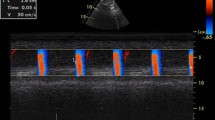Abstract
The main objective of this study is to investigate the relationship between ascending aorta elasticity and the severity of coronary artery stenosis in essential hypertensive patients with coronary heart disease (CHD) using M-mode and tissue Doppler echocardiography. A total of 184 hypertensive patients with CHD were enrolled. Patients were divided into three groups based on the severity of coronary stenosis measured by coronary arteriography (CAG): slight stenosis (group 1), moderate stenosis (group 2) and serious stenosis (group 3). M-mode and tissue Doppler echocardiography were performed, and elasticity indexes of ascending aorta including stiffness index, distensibility index, and S wave speed of anterior wall were calculated and correlated with the severity of coronary stenosis. Ascending aorta stiffness index was increased, whereas distensibility index and S wave speed of anterior wall were decreased in moderate and severe stenosis groups compared with slight stenosis group (P < 0.01). Elasticity indexes change in a stepwise pattern with the narrowness of coronary artery, and there was a significant correlation between aortic elasticity and severity of coronary artery by Pearson correlation analysis (P < 0.01). Elasticity indexes of ascending aorta correlate well with severity of coronary stenosis. Elasticity indexes of ascending aorta can serve as predictors for coronary arterial lesion in hypertensive patients.
Similar content being viewed by others
References
WHO causes of death 2008 summary tables.
Laurent, S., Boutouyrie, P., Asmar, R., Gautier, I., Laloux, B., Guize, L., et al. (2001). Aortic stiffness is an independent predictor of all-cause and cardiovascular mortality in hypertensive patients. Hypertension, 37, 1236–1241.
Laurent, S., Cockcroft, J., Van Bortel, L., Boutouyrie, P., Giannattasio, C., Hayoz, D., et al. (2006). European Network for non-invasive investigation of large arteries. Expert consensus document on arterial stiffness: Methodological issues and clinical applications. European Heart Journal, 27, 2588–2605.
Mottram, P. M., Haluska, B. A., Leano, R., et al. (2005). Relation of arterial stiffness to diastolic dysfunction in hypertensive heart disease. Heart, 91, 1551–1556.
Mohiaddin, R. H., Underwood, S. R., Bogren, H. G., et al. (1989). Regional aortic compliance studied by magnetic resonance imaging: The effects of age, training and coronary heart disease. British Heart Journal, 62, 90–96.
Stefanadis, C., Stratos, C., Vlachopoulos, C., et al. (1995). Pressure-diameter relation of the human aorta. A new method of determination by the application of a special ultrasonic dimension catheter. Circulation, 92, 2210–2219.
Schmidt-Trucksass, A., Grathwohl, D., Schmid, A., et al. (1998). Assessment of carotid wall motion and stiffness with tissue Doppler imaging. Ultrasound in Medicine and Biology, 24, 639–646.
Yin, Quanzhong, Gao, Chunheng, Zheng, Ruolong, et al. (2007). Ascending aorta elastic and early—onset correlation between the degree of stenosis of coronary atherosclerotic heart disease. Jiangsu University Acta: Medicine, 17(2), 142–144.
Gensini, G. G. (1983). A more meaningful scoring system for determining the severity of coronary heart disease. American Journal of Cardiology, 51, 606–607.
Stefanadis, C., Stratos, C., Vlachopoulos, C., Marakas, S., Boudoulas, H., Kallikazaros, I., et al. (1995). Pressure diameter relation of the human aorta: A new method of determination by the application of a special ultrasonic dimension catheter. Circulation, 92, 2210–2219.
Stefanadis, C., Dernellis, J., Vlachopoulos, C., Tsioufis, C., Tsiamis, E., Toutouzas, K., et al. (1997). Aortic function in arterial hypertension determined by pressure-diameter relation: Effects of diltiazem. Circulation, 96, 1853–1858.
Edwards, M. S., & Corriere, M. A. (2009). Contemporary management of atherosclerotic renovascular disease. Journal of Vascular Surgery, 50(5), 1197–1210. ISSN 0741-5214.
Vlachopoulos, C., Aznaouridis, K., & Stefanadis, C. (2010). Prediction of cardiovascular events and all-cause mortality with arterial stiffness: A systematic review and meta-analysis. Journal of the American College of Cardiology, 55(13), 1318–1327.
Eryol, N. K., Topsakal, R., Cicek, Y., Abacı, A., Oguzhan, A., Basar, E., et al. (2002). Colour Doppler tissue imaging in assessing the elastic properties of the aorta and in predicting coronary artery disease. Japanese Heart Journal, 43, 219–230.
Herrington, D. M., Kesler, K., Reiber, J. C., et al. (2003). Arterial compliance adds to conventional risk factors for prediction of angiographic coronary artery disease. American Heart Journal, 146(4), 662–667.
Yildiz, A., Gur, M., Yilmaz, R., et al. (2008). The association of elasticity indexs of ascending aorta and the presence and the severity of coronary artery diseses. Coronary Artery Disease, 19(5), 311–317.
Ahmadi, N., Nabavi, V., […], & Budoff, M.J. (2011). Impaired aortic distensibility measured by computed tomography is associated with the severity of coronary artery disease. The International Journal of Cardiovascular Imaging, 27(3), 459–469.
Vitarelli, A., Giordano, M., Germanò, G., Pergolini, M., Cicconetti, P., Tomei, F., et al. (2010). Assessment of ascending aorta wall stiffness in hypertensive patients by tissue Doppler imaging and strain Doppler echocardiography. Heart, 96(18), 1469–1474.
O’Rourke, M. F. (2008). How stiffening of the aorta and elastic arteries leads to compromised coronary flow. Heart, 94(6), 690–691.
Vitarelli, A., Conde, Y., Cimino, E., et al. (2006). Assessment of aortic wall mechanics in Marfan syndrome by transesophageal tissue Doppler echocardiography. American Journal of Cardiology, 97, 571–577.
Author information
Authors and Affiliations
Corresponding author
Rights and permissions
About this article
Cite this article
Lu, Q., Liu, H. Correlation of Ascending Aorta Elasticity and the Severity of Coronary Artery Stenosis in Hypertensive Patients with Coronary Heart Disease Assessed by M-Mode and Tissue Doppler Echocardiography. Cell Biochem Biophys 71, 785–788 (2015). https://doi.org/10.1007/s12013-014-0263-3
Published:
Issue Date:
DOI: https://doi.org/10.1007/s12013-014-0263-3




